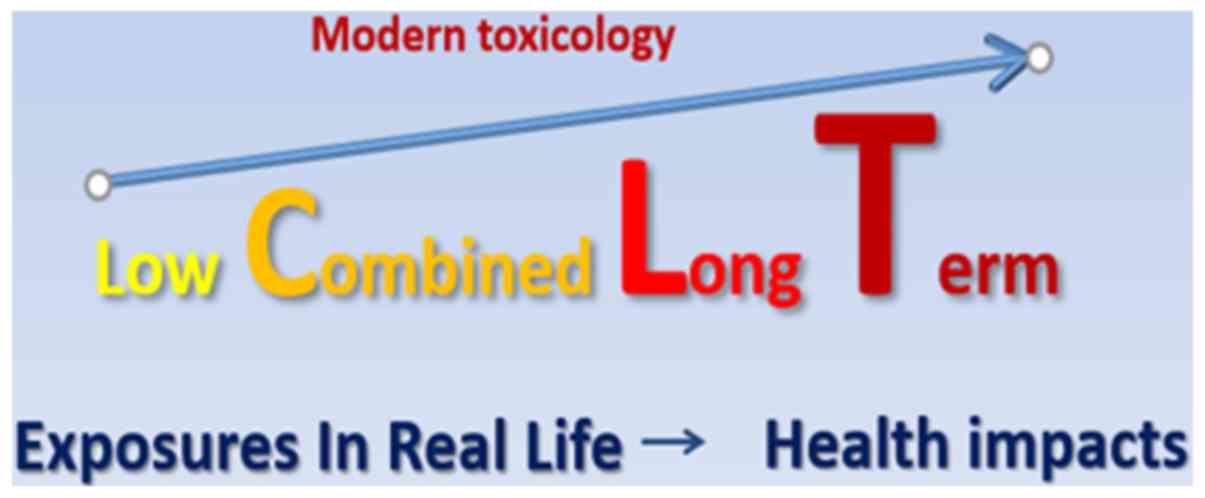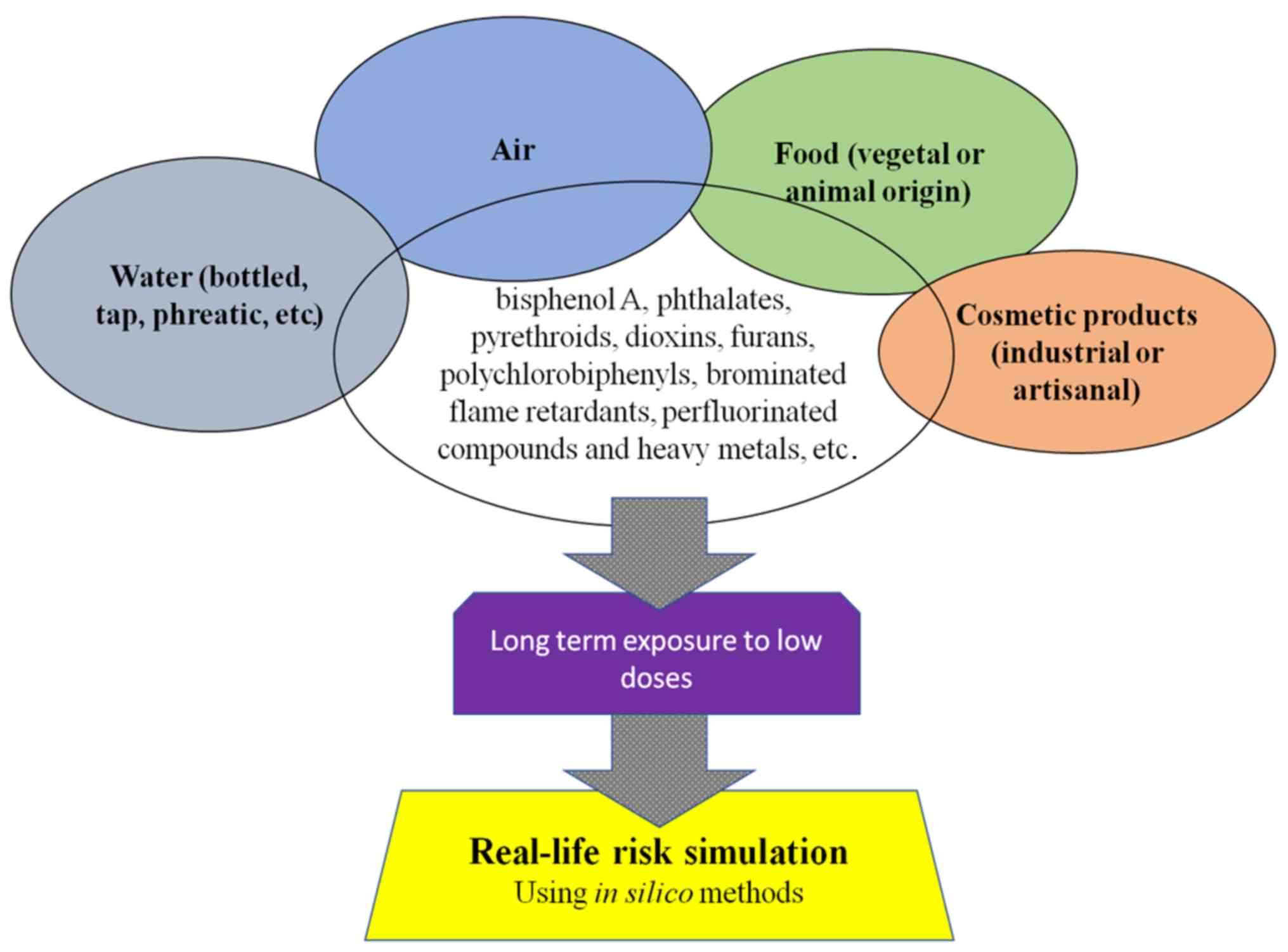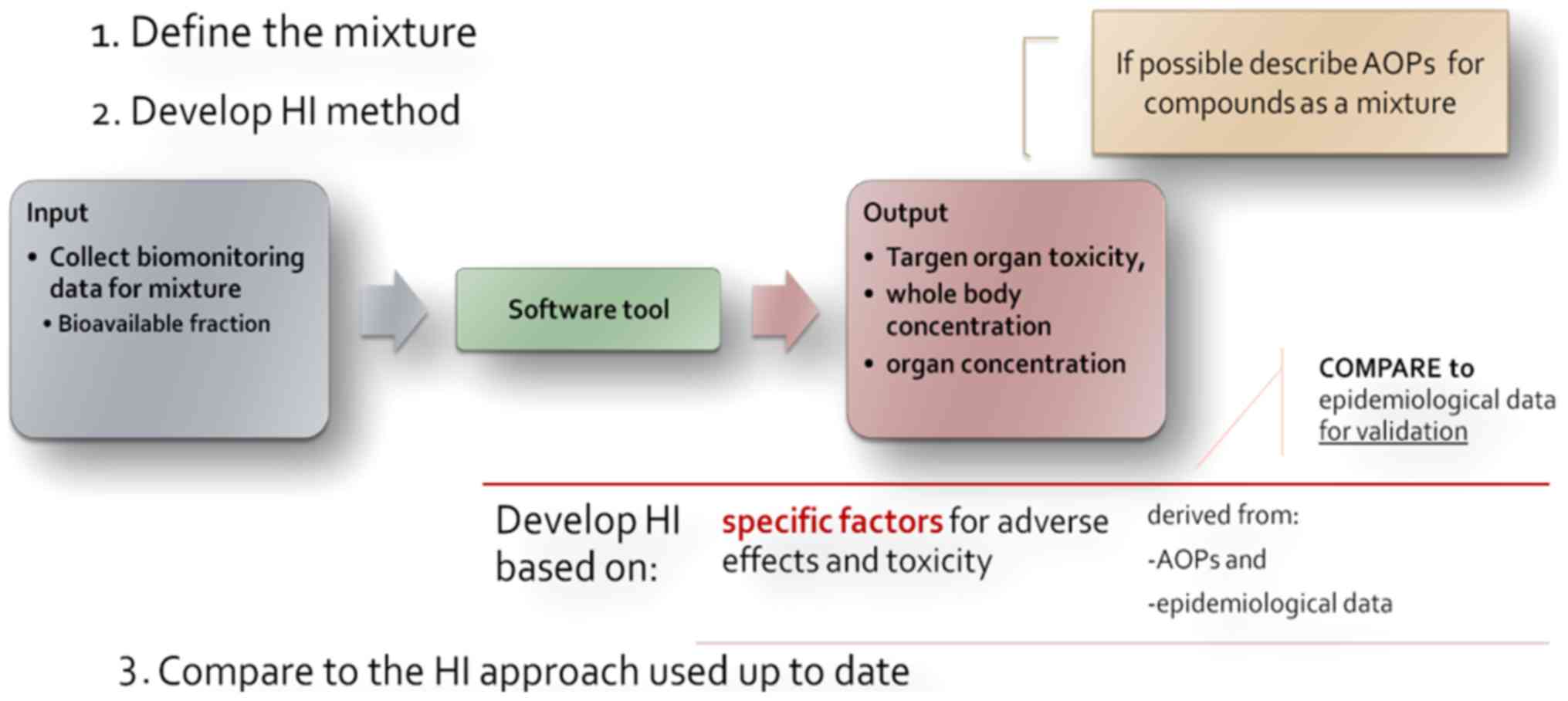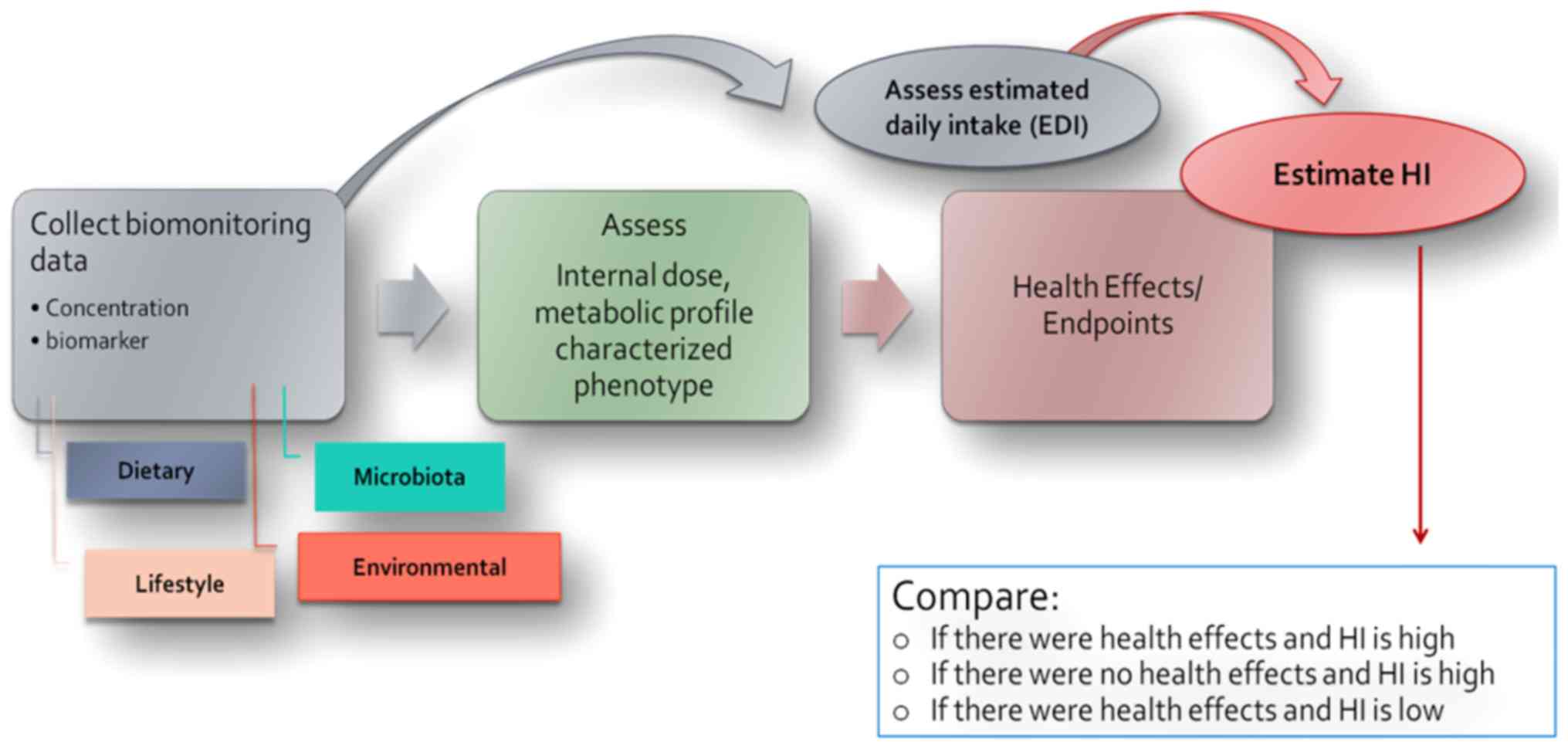|
1
|
Dereumeaux C, Saoudi A, Pecheux M, Berat
B, de Crouy-Chanel P, Zaros C, Brunel S, Delamaire C, le Tertre A,
Lefranc A, et al: Biomarkers of exposure to environmental
contaminants in French pregnant women from the Elfe cohort in 2011.
Environ Int. 97:56–67. 2016.PubMed/NCBI View Article : Google Scholar
|
|
2
|
Tsatsakis A, Goumenou M, Liesivuori J,
Dekant W and Hernández AF: Toxicology for real-life risk simulation
- Editorial preface to this special issue. Toxicol Lett. 309:33–34.
2019.PubMed/NCBI View Article : Google Scholar
|
|
3
|
Kar S and Leszczynski J: Exploration of
Computational Approaches to Predict the Toxicity of Chemical
Mixtures. Toxics. 7(7)2019.PubMed/NCBI View Article : Google Scholar
|
|
4
|
da Fonseca TG, Abessa DMS and Bebianno MJ:
Effects of mixtures of anticancer drugs in the benthic polychaete
Nereis diversicolor. Environ Pollut. 252 (Pt B):1180–1192.
2019.PubMed/NCBI View Article : Google Scholar
|
|
5
|
Thrupp TJ, Runnalls TJ, Scholze M,
Kugathas S, Kortenkamp A and Sumpter JP: The consequences of
exposure to mixtures of chemicals: Something from ‘nothing’ and ‘a
lot from a little’ when fish are exposed to steroid hormones. Sci
Total Environ. 619-620:1482–1492. 2018.PubMed/NCBI View Article : Google Scholar
|
|
6
|
Tsatsakis AM, Docea AO, Calina D, Buga AM,
Zlatian O, Gutnikov S, Kostoff RN and Aschner M: Hormetic
Neurobehavioral effects of low dose toxic chemical mixtures in
real-life risk simulation (RLRS) in rats. Food Chem Toxicol.
125:141–149. 2019.PubMed/NCBI View Article : Google Scholar
|
|
7
|
Tsatsakis AM, Docea AO and Tsitsimpikou C:
New challenges in risk assessment of chemicals when simulating real
exposure scenarios; simultaneous multi-chemicals' low dose
exposure. Food Chem Toxicol. 96:174–176. 2016.PubMed/NCBI View Article : Google Scholar
|
|
8
|
Tsatsakis AM, Kouretas D, Tzatzarakis MN,
Stivaktakis P, Tsarouhas K, Golokhvast KS, Rakitskii VN, Tutelyan
VA, Hernandez AF, Rezaee R, et al: Simulating real-life exposures
to uncover possible risks to human health: A proposed consensus for
a novel methodological approach. Hum Exp Toxicol. 36:554–564.
2017.PubMed/NCBI View Article : Google Scholar
|
|
9
|
Kostoff RN, Goumenou M and Tsatsakis A:
The role of toxic stimuli combinations in determining safe exposure
limits. Toxicol Rep. 5:1169–1172. 2018.PubMed/NCBI View Article : Google Scholar
|
|
10
|
Docea AO, Calina D, Goumenou M, Neagu M,
Gofita E and Tsatsakis A: Study design for the determination of
toxicity from long-term-low-dose exposure to complex mixtures of
pesticides, food additives and lifestyle products. Toxicol Lett.
258(S179)2016. View Article : Google Scholar
|
|
11
|
Docea AO, Gofita E, Goumenou M, Calina D,
Rogoveanu O, Varut M, Olaru C, Kerasioti E, Fountoucidou P,
Taitzoglou I, et al: Six months exposure to a real life mixture of
13 chemicals' below individual NOAELs induced non monotonic
sex-dependent biochemical and redox status changes in rats. Food
Chem Toxicol. 115:470–481. 2018.PubMed/NCBI View Article : Google Scholar
|
|
12
|
Docea AO, Goumenou M, Calina D, Arsene AL,
Dragoi CM, Gofita E, Pisoschi CG, Zlatian O, Stivaktakis PD,
Nikolouzakis TK, et al: Adverse and hormetic effects in rats
exposed for 12 months to low dose mixture of 13 chemicals: RLRS
part III. Toxicol Lett. 310:70–91. 2019.PubMed/NCBI View Article : Google Scholar
|
|
13
|
Renieri EA, Goumenou M, Kardonsky DA,
Veselov VV, Alegakis AΚ, Buha A, Tzatzarakis MN, Nosyrev AE,
Rakitskii VN, Kentouri M, et al: Indicator PCBs in farmed and wild
fish in Greece - Risk assessment for the Greek population. Food
Chem Toxicol. 127:260–269. 2019.PubMed/NCBI View Article : Google Scholar
|
|
14
|
Mesnage R, Antoniou MN, Tsoukalas D,
Goulielmos GN and Tsatsakis A: Gut microbiome metagenomics to
understand how xenobiotics impact human health. Curr Opin Toxicol.
11-12:51–58. 2018.
|
|
15
|
Tsiaoussis J, Antoniou MN, Koliarakis I,
Mesnage R, Vardavas CI, Izotov BN, Psaroulaki A and Tsatsakis A:
Effects of single and combined toxic exposures on the gut
microbiome: Current knowledge and future directions. Toxicol Lett.
312:72–97. 2019.PubMed/NCBI View Article : Google Scholar
|
|
16
|
Espinoza JL: Machine learning for tackling
microbiota data and infection complications in immunocompromised
patients with cancer. J Intern Med. 284:189–192. 2018.PubMed/NCBI View Article : Google Scholar
|
|
17
|
Ribeiro E and Ladeira C and Viegas S: EDCs
Mixtures: A Stealthy Hazard for Human Health? Toxics.
5(E5)2017.PubMed/NCBI View Article : Google Scholar
|
|
18
|
Street ME, Angelini S, Bernasconi S,
Burgio E, Cassio A, Catellani C, Cirillo F, Deodati A, Fabbrizi E,
Fanos V, et al: Current knowledge on endocrine disrupting chemicals
(EDCs) from animal biology to humans, from pregnancy to adulthood:
Highlights from a national italian meeting. Int J Mol Sci.
19(E1647)2018.PubMed/NCBI View Article : Google Scholar
|
|
19
|
Munn S and Goumenou M: Thresholds for
Endocrine Disrupters and Related Uncertainties. Report of the
Endocrine Disrupters Expert Advisory Group. Publications Office of
the European Union, 2013. https://publications.europa.eu/en/publication-detail/-/publication/a1a68b31-c013-484a-b4f0-ce089822aad8/language-en.
Accessed July 11. 2014.
|
|
20
|
Day P, Green RM, Gross M, Weltje L and
Wheeler JR: Endocrine Disruption: Current approaches for regulatory
testing and assessment of plant protection products are fit for
purpose. Toxicol Lett. 296:10–22. 2018.PubMed/NCBI View Article : Google Scholar
|
|
21
|
International Programme on Chemical
Safety: Global assessment on the state of the science of endocrine
disruptors. World Health Organization, Geneva, 2002. https://apps.who.int/iris/handle/10665/67357.
|
|
22
|
Munn S and Goumenou M: Key scientific
issues relevant to the identification and characterisation of
endocrine disrupting substances. Report of the Endocrine Disrupters
Expert Advisory Group. Publications Office of the European Union,
2013. https://publications.europa.eu/en/publication-detail/-/publication/4b84ccc2-422d-4bd1-97da-1f414ad52c27/language-en.
Accessed April 2. 2013.
|
|
23
|
European Chemicals Agency (ECHA) and
European Food Safety Authority (EFSA) with support from the Joint
Research Centre (JRC): Guidance for the identification of endocrine
disruptors in the context of Regulations (EU) No 528/2012 and (EC)
No 1107/2009. EFSA J 16: e05311, 2018.
|
|
24
|
Schug TT, Johnson AF, Birnbaum LS, Colborn
T, Guillette LJ Jr, Crews DP, Collins T, Soto AM, Vom Saal FS,
McLachlan JA, et al: Minireview: Endocrine Disruptors: Past Lessons
and Future Directions. Mol Endocrinol. 30:833–847. 2016.PubMed/NCBI View Article : Google Scholar
|
|
25
|
Darbre PD: Endocrine Disruptors and
Obesity. Curr Obes Rep. 6:18–27. 2017.PubMed/NCBI View Article : Google Scholar
|
|
26
|
Ravichandran G, Lakshmanan DK, Raju K,
Elangovan A, Nambirajan G, Devanesan AA and Thilagar S: Food
advanced glycation end products as potential endocrine disruptors:
An emerging threat to contemporary and future generation. Environ
Int. 123:486–500. 2019.PubMed/NCBI View Article : Google Scholar
|
|
27
|
Lee YM, Jacobs DR Jr and Lee DH:
Persistent Organic Pollutants and Type 2 Diabetes: A Critical
Review of Review Articles. Front Endocrinol (Lausanne).
9(712)2018.PubMed/NCBI View Article : Google Scholar
|
|
28
|
Lind PM and Lind L: Endocrine-disrupting
chemicals and risk of diabetes: An evidence-based review.
Diabetologia. 61:1495–1502. 2018.PubMed/NCBI View Article : Google Scholar
|
|
29
|
Idowu O, Semple KT, Ramadass K, O'Connor
W, Hansbro P and Thavamani P: Beyond the obvious: Environmental
health implications of polar polycyclic aromatic hydrocarbons.
Environ Int. 123:543–557. 2019.PubMed/NCBI View Article : Google Scholar
|
|
30
|
Di Nisio A and Foresta C: Water and soil
pollution as determinant of water and food quality/contamination
and its impact on male fertility. Reprod Biol Endocrinol.
17(4)2019.PubMed/NCBI View Article : Google Scholar
|
|
31
|
Rahmani S, Pour Khalili N, Khan F, Hassani
S, Ghafour-Boroujerdi E, Abdollahi M and Bisphenol A: Bisphenol A:
What lies beneath its induced diabetes and the epigenetic
modulation? Life Sci. 214:136–144. 2018.PubMed/NCBI View Article : Google Scholar
|
|
32
|
Petrakis D, Vassilopoulou L, Mamoulakis C,
Psycharakis C, Anifantaki A, Sifakis S, Docea AO, Tsiaoussis J,
Makrigiannakis A and Tsatsakis AM: Endocrine Disruptors Leading to
Obesity and Related Diseases. Int J Environ Res Public Health.
14(1282)2017.PubMed/NCBI View Article : Google Scholar
|
|
33
|
Trasande L, Zoeller RT, Hass U, Kortenkamp
A, Grandjean P, Myers JP, DiGangi J, Bellanger M, Hauser R, Legler
J, et al: Estimating burden and disease costs of exposure to
endocrine-disrupting chemicals in the European union. J Clin
Endocrinol Metab. 100:1245–1255. 2015.PubMed/NCBI View Article : Google Scholar
|
|
34
|
Attina TM, Hauser R, Sathyanarayana S,
Hunt PA, Bourguignon JP, Myers JP, DiGangi J, Zoeller RT and
Trasande L: Exposure to endocrine-disrupting chemicals in the USA:
A population-based disease burden and cost analysis. Lancet
Diabetes Endocrinol. 4:996–1003. 2016.PubMed/NCBI View Article : Google Scholar
|
|
35
|
De Coster S and van Larebeke N:
Endocrine-disrupting chemicals: Associated disorders and mechanisms
of action. J Environ Public Health. 2012(713696)2012.PubMed/NCBI View Article : Google Scholar
|
|
36
|
Luechtefeld T, Marsh D, Rowlands C and
Hartung T: Machine Learning of Toxicological Big Data Enables
Read-Across Structure Activity Relationships (RASAR) Outperforming
Animal Test Reproducibility. Toxicol Sci. 165:198–212.
2018.PubMed/NCBI View Article : Google Scholar
|
|
37
|
Ding D, Xu L, Fang H, Hong H, Perkins R,
Harris S, Bearden ED, Shi L and Tong W: The EDKB: An established
knowledge base for endocrine disrupting chemicals. BMC
Bioinformatics. 11 (Suppl 6)(S5)2010.PubMed/NCBI View Article : Google Scholar
|
|
38
|
Castello P, Wittwehr C and Goumenou MP:
Endocrine Active Substances Information System (EASIS) Software
Implementation Plan. Technical Report. EU PUBSY No. JRC76923.
2012.
|
|
39
|
OECD: Revised Guidance Document 150 on
Standardised Test Guidelines for Evaluating Chemicals forEndocrine
Disruption OECD Series on Testing and Assessment. OECD Publishing,
Paris, 2018. https://doi.org/10.1787/9789264304741-en.
|
|
40
|
Browne P, Noyes PD, Casey WM and Dix DJ:
Application of adverse outcome pathways to U.S. EPA's endocrine
disruptor screening program. Environ Health Perspect.
125(096001)2017.PubMed/NCBI View Article : Google Scholar
|
|
41
|
Mesnage R, Biserni M, Genkova D,
Wesolowski L and Antoniou MN: Evaluation of neonicotinoid
insecticides for oestrogenic, thyroidogenic and adipogenic activity
reveals imidacloprid causes lipid accumulation. J Appl Toxicol.
38:1483–1491. 2018.PubMed/NCBI View Article : Google Scholar
|
|
42
|
Mesnage R, Phedonos A, Arno M, Balu S,
Corton JC and Antoniou MN: Editor's Highlight: Transcriptome
Profiling Reveals Bisphenol A Alternatives Activate Estrogen
Receptor Alpha in Human Breast Cancer Cells. Toxicol Sci.
158:431–443. 2017.PubMed/NCBI View Article : Google Scholar
|
|
43
|
Raies AB and Bajic VB: In silico
toxicology: Computational methods for the prediction of chemical
toxicity. Wiley Interdiscip Rev Comput Mol Sci. 6:147–172.
2016.PubMed/NCBI View Article : Google Scholar
|
|
44
|
Delfosse V, Dendele B, Huet T, Grimaldi M,
Boulahtouf A, Gerbal-Chaloin S, Beucher B, Roecklin D, Muller C,
Rahmani R, et al: Synergistic activation of human pregnane X
receptor by binary cocktails of pharmaceutical and environmental
compounds. Nat Commun. 6(8089)2015.PubMed/NCBI View Article : Google Scholar
|
|
45
|
Sarigiannis DA and Gotti A: Biology-based
dose-response models for health risk assessment of chemical
mixtures. Fresenius Environ Bull. 17:1439–1451. 2008.PubMed/NCBI View Article : Google Scholar
|
|
46
|
Vuorinen A, Odermatt A and Schuster D: In
silico methods in the discovery of endocrine disrupting chemicals.
J Steroid Biochem Mol Biol. 137:18–26. 2013.PubMed/NCBI View Article : Google Scholar
|
|
47
|
Wahl J and Smieško M: Endocrine Disruption
at the Androgen Receptor: Employing Molecular Dynamics and Docking
for Improved Virtual Screening and Toxicity Prediction. Int J Mol
Sci. 19(1784)2018.PubMed/NCBI View Article : Google Scholar
|
|
48
|
Kar S, Ghosh S and Leszczynski J: Single
or mixture halogenated chemicals? Risk assessment and developmental
toxicity prediction on zebrafish embryos based on weighted
descriptors approach. Chemosphere. 210:588–596. 2018.PubMed/NCBI View Article : Google Scholar
|
|
49
|
Mansouri K, Abdelaziz A, Rybacka A,
Roncaglioni A, Tropsha A, Varnek A, Zakharov A, Worth A, Richard
AM, Grulke CM, et al: CERAPP: Collaborative Estrogen Receptor
Activity Prediction Project. Environ Health Perspect.
124:1023–1033. 2016.PubMed/NCBI View Article : Google Scholar
|
|
50
|
Kaserer T, Beck RK, Akram M, Odermatt A
and Schuster D: Pharmacophore Models and Pharmacophore-Based
Virtual Screening: Concepts and Applications Exemplified on
Hydroxysteroid Dehydrogenases. Molecules. 20:22799–22832.
2015.PubMed/NCBI View Article : Google Scholar
|
|
51
|
Ruiz P, Sack A, Wampole M, Bobst S and
Vracko M: Integration of in silico methods and computational
systems biology to explore endocrine-disrupting chemical binding
with nuclear hormone receptors. Chemosphere. 178:99–109.
2017.PubMed/NCBI View Article : Google Scholar
|
|
52
|
Robinson-Rechavi M, Carpentier A-S,
Duffraisse M and Laudet V: How many nuclear hormone receptors are
there in the human genome? Trends Genet. 17:554–556.
2001.PubMed/NCBI View Article : Google Scholar
|
|
53
|
Wang Z, Liu H and Liu S: Low-Dose
Bisphenol A Exposure: A Seemingly Instigating Carcinogenic Effect
on Breast Cancer. Adv Sci (Weinh). 4(1600248)2016.PubMed/NCBI View Article : Google Scholar
|
|
54
|
Nohynek GJ, Borgert CJ, Dietrich D and
Rozman KK: Endocrine disruption: Fact or urban legend? Toxicol
Lett. 223:295–305. 2013.PubMed/NCBI View Article : Google Scholar
|
|
55
|
Schneider S, Fussell KC, Melching-Kollmuss
S, Buesen R, Gröters S, Strauss V, Jiang X and van Ravenzwaay B:
Investigations on the dose-response relationship of combined
exposure to low doses of three anti-androgens in Wistar rats. Arch
Toxicol. 91:3961–3989. 2017.PubMed/NCBI View Article : Google Scholar
|
|
56
|
Roszko MŁ, Kamińska M, Szymczyk K,
Piasecka-Jóźwiak K and Chabłowska B: Endocrine disrupting potency
of organic pollutant mixtures isolated from commercial fish oil
evaluated in yeast-based bioassays. PLoS One.
13(e0197907)2018.PubMed/NCBI View Article : Google Scholar
|
|
57
|
Seeger B, Klawonn F, Nguema Bekale B and
Steinberg P: Mixture Effects of Estrogenic Pesticides at the Human
Estrogen Receptor α and β. PLoS One. 11(e0147490)2016.PubMed/NCBI View Article : Google Scholar
|
|
58
|
Vandenberg LN, Colborn T, Hayes TB,
Heindel JJ, Jacobs DR Jr, Lee DH, Shioda T, Soto AM, vom Saal FS,
Welshons WV, et al: Hormones and endocrine-disrupting chemicals:
Low-dose effects and nonmonotonic dose responses. Endocr Rev.
33:378–455. 2012.PubMed/NCBI View Article : Google Scholar
|
|
59
|
Sarigiannis D, Gotti A, Cimino Reale G and
Marafante E: Reflections on new directions for risk assessment of
environmental chemical mixtures. Int J Risk Assess Manag.
13:216–241. 2009. View Article : Google Scholar
|
|
60
|
Bliss CI: The calculation of the
dosage-mortality curve. Ann Appl Biol. 22:134–167. 1935. View Article : Google Scholar
|
|
61
|
Sarigiannis DAHU and Hansen U: Considering
the cumulative risk of mixtures of chemicals - a challenge for
policy makers. Environ Health. 11 (Suppl 1)(S18)2012.PubMed/NCBI View Article : Google Scholar
|
|
62
|
Goumenou M and Tsatsakis A: Proposing new
approaches for the risk characterisation of single chemicals and
chemical mixtures: The source related Hazard Quotient (HQS) and
Hazard Index (HIS) and the adversity specific Hazard Index (HIA).
Toxicol Rep. 6:632–636. 2019.PubMed/NCBI View Article : Google Scholar
|
|
63
|
Katsikantami I, Colosio C, Alegakis A,
Tzatzarakis MN, Vakonaki E, Rizos AK, Sarigiannis DA and Tsatsakis
AM: Estimation of daily intake and risk assessment of
organophosphorus pesticides based on biomonitoring data - The
internal exposure approach. Food Chem Toxicol. 123:57–71.
2019.PubMed/NCBI View Article : Google Scholar
|
|
64
|
Papadakis GZ, Karantanas AH, Tsiknakis M,
Tsatsakis A, Spandidos DA and Marias K: Deep learning opens new
horizons in personalized medicine. Biomed Rep. 10:215–217.
2019.PubMed/NCBI View Article : Google Scholar
|


















